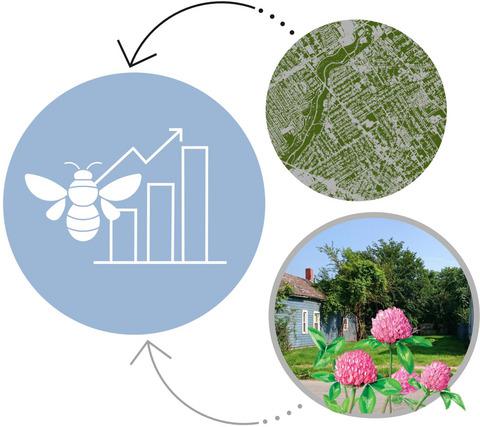当前位置:
X-MOL 学术
›
J. Appl. Ecol.
›
论文详情
Our official English website, www.x-mol.net, welcomes your
feedback! (Note: you will need to create a separate account there.)
Conservation in post‐industrial cities: How does vacant land management and landscape configuration influence urban bees?
Journal of Applied Ecology ( IF 5.0 ) Pub Date : 2020-09-26 , DOI: 10.1111/1365-2664.13773 Katherine J. Turo 1 , MaLisa R. Spring 1 , Frances S. Sivakoff 2 , Yvan A. Delgado de la flor 1 , Mary M. Gardiner 1
中文翻译:

后工业城市的保护:空置土地管理和景观配置如何影响城市蜜蜂?
更新日期:2020-09-26
Journal of Applied Ecology ( IF 5.0 ) Pub Date : 2020-09-26 , DOI: 10.1111/1365-2664.13773 Katherine J. Turo 1 , MaLisa R. Spring 1 , Frances S. Sivakoff 2 , Yvan A. Delgado de la flor 1 , Mary M. Gardiner 1
Affiliation

|
- Rich pollinator assemblages are documented in some cities despite habitat fragmentation and degradation, suggesting that urban areas have potential as pollinator refuges. To inform urban bee conservation, we assessed local‐ and landscape‐scale drivers of bee community composition and foraging within vacant lots of Cleveland, Ohio, USA. Cleveland is a shrinking city, a type of urban area that has an over‐abundance of vacated greenspaces as a result of population loss and subsequent demolition of abandoned infrastructure. As such, Cleveland represents over 350 post‐industrial cities worldwide that are all promising locations for bee conservation.
- Across a network of 56 residential vacant lots (each ~30 m × 12 m), we established seven unique habitats, including seeded native prairies, to investigate how vegetation management and landscape context at a 1,500 m radius influenced urban bee communities. We assessed the distribution of several bee functional traits, diversity and abundance with pan and malaise traps. Foraging frequency was determined with plant–pollinator interaction networks derived from vacuum collections of bees at flowers.
- We observed higher bee richness and increased abundance of smaller sized bees as the size of surrounding greenspace patches increased within a 1,500 m radius landscape buffer. Within habitats, seeded treatments had no effect on bees but greater plant biomass and shorter vegetation were correlated with increased bee richness and abundance. Plant–pollinator interaction networks were dominated by spontaneous non‐native vegetation, illustrating that this forage supports urban bees.
- Synthesis and applications. Our study indicates that proximity to larger greenspaces within an urban landscape promotes overall bee richness and increased occurrence of smaller bee species within residential vacant lots. While we did not observe our seeded native plants enhancing the bee community, native wildflowers were still establishing during the study and may have a greater influence when blooming at higher densities. Importantly, spontaneous non‐native vegetation provided the majority of urban bee's forage. Thus, vacant land that is minimally managed and vegetated with what many consider undesirable ‘weeds’ provides valuable habitat for bee conservation in cities.
中文翻译:

后工业城市的保护:空置土地管理和景观配置如何影响城市蜜蜂?
- 尽管栖息地遭到破坏和退化,但仍有一些城市记录了丰富的传粉媒介,这表明城市地区有可能成为传粉媒介的避难所。为了指导城市养蜂,我们评估了美国俄亥俄州克利夫兰市空地上蜂群组成和觅食的当地和景观尺度驱动因素。克利夫兰是一个正在萎缩的城市,这种城市地区由于人口流失以及随后拆除废弃的基础设施而拥有过多的闲置绿地。因此,克利夫兰代表着全球350多个后工业城市,它们都是养蜂业的有希望的地方。
- 在一个由56个住宅空地组成的网络中(每个〜30 m×12 m),我们建立了七个独特的栖息地,包括带种子的原始大草原,以调查1,500 m半径内的植被管理和景观环境如何影响城市蜂群。我们用锅和不适的陷阱评估了几种蜜蜂功能性状的分布,多样性和丰度。觅食频率是由植物-授粉媒介相互作用网络确定的,该网络来自花朵上蜜蜂的真空收集。
- 我们观察到,随着周围绿地斑块的大小在半径1,500 m的景观缓冲区内增加,蜂类的丰富度更高,蜂巢数量也增加。在生境中,播种处理对蜜蜂没有影响,但更大的植物生物量和较短的植被与蜜蜂的丰富度和丰度相关。植物与传粉媒介的相互作用网络主要是自发的非本地植被,这说明这种草料支持城市蜜蜂。
- 综合与应用。我们的研究表明,靠近城市景观内的较大绿地可促进总体蜂类丰富度,并增加居住空地内较小蜜蜂物种的发生。虽然我们没有观察到我们的种子天然植物增强蜜蜂群落,但在研究过程中仍在建立天然野花,当以更高的密度开花时,它们可能会产生更大的影响。重要的是,自发的非本地植被提供了城市蜜蜂的大部分饲料。因此,对空置土地的管理和植被得到最小化,许多人认为这是不受欢迎的“杂草”,为城市养蜂提供了宝贵的栖息地。











































 京公网安备 11010802027423号
京公网安备 11010802027423号